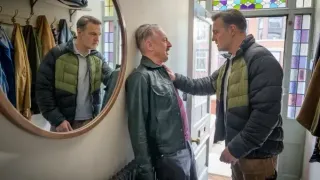February 7, 2016
Museum's Stellar Return in Berkeley
Sura Wood READ TIME: 5 MIN.
The Berkeley Art Museum and Pacific Film Archive [BAMPFA], which was forced to relocate after their concrete, cave-like Mario Ciampi-designed building on Bancroft Street was deemed seismically unsafe, made a stellar return last week in a renovated, red, white and stainless steel Art Deco facility in downtown Berkeley.
Though, at 83,000 square feet, the amount of space remains roughly equivalent to that of the previous site, the new, tri-level venue, across from the entrance to the UC Campus, boasts white-walled, flexible galleries with plenty of room to move and linger, ranging from a 10,000 sq. ft. space that can be divided with temporary walls to a 750 sq. ft. jewel-box gallery; picture windows with views to the street; and a pair of state-of-the-art movie theaters - one seating 232, the other 33 - with excellent sight-lines and high-end acoustics for the Pacific Film Archive, plus a large outdoor LED monitor that allows for free public screenings of digital media projects. A prime attraction of the location is its close proximity to BART, a relief for anyone who has ever had to contend with parking on the upper campus.
BAMPFA's new home is a 1939 UC Berkeley printing plant "repurposed" by Diller Scofidio + Renfro Architects, who've integrated a curvilinear machine aesthetic and given the streamlined moderne, late Deco style a 21st-century panache. Initial plans to hire the adventurous Japanese architecture firm Toyo Ito and Associates were scrapped mostly due to financial concerns after the 2008 crash and subsequent recession; the budget for that project was in the neighborhood of $200 million, but the current building cost substantially less.
While one can only speculate on what might have been, the end-product is an elegant, well-designed if not wholly inspiring building with clean lines and a relatively modest exterior whose greatest asset is the light-filled main-floor galleries. They certainly provide a luxuriously spacious backdrop for over 250 artworks displayed in the inaugural exhibition, "Architecture of Life," which occupies almost the entire museum.
Curated by BAMPFA director Lawrence Rinder, the show explores architecture as metaphor, an ambitious if overly broad concept that encompasses almost anything and everything of aesthetic beauty. The eclectic mix of objects, intended to reflect the encyclopedic nature of the museum's holdings and curatorial interests (only 15% of the pieces are from the permanent collections), dates from the second century and the Renaissance to the present, drawing from the Americas, Asia, Africa and Europe.
But the show is at its best when it hews to the role of architecture and design in society, a theme reflected in works such as Achilles (A.G.) Rizzoli's whimsical mid-1930s architectural ink drawings of imaginary buildings designed to represent neighbors, friends or family members; "Home-for-All" in Rikuzentakata, a selection of fascinating, meticulously constructed scale models created by Toyo Ito and three other Japanese architects following the devastation wreaked by the 2011 earthquake and tsunami on a coastal community; Rosie Lee Tompkins' grid-structured, midnight-blue quilt; and Chris Johanson's "Cityscape with House & Gray Energy" (2003), where a larger primary-colored canvas of a dense, hilly urban landscape is connected by a narrow wooden strip to a smaller depiction of the artist's San Jose childhood home on one adjoining wall and an abstract gray square of a psychological interior on the other. Together they mimic the network of a neighborhood and hint at the co-existence of internal and exterior lives.
"The World Garden," a commissioned "art wall" mural that hijacks your attention as soon as you enter the museum, represents the cacophony of contemporary global life and its woes. Done in an ink-brush technique by Chinese artist Qiu Zhijie, the 60' wide by 30' high satiric epic, which merges classical Chinese landscape and Italian Renaissance gardens with Northern Song Dynasty panoramic scroll painting, signals a sardonic view of the modern age, with handwritten names of destination such as "Peak of Impermanence," "Chill," "Mt. Sensory Management," and "Holiday in Distance."
A notable advantage of the new space is its enclosed galleries that are more conducive to sound and video installations than the open-floor plan of the old building. Among the half-dozen videos is Ben Rivers' "Origin of the Species." Projected inside a wood shed with aluminum siding, the junky "mini-theater" recalls the abandoned Southern California wasteland installations of artist Michael C. McMillen. "Gravity Was Everywhere Back Then," a video from artist-animator-filmmaker Brent Green, chronicles the odd life-story of Leonard Wood, a Louisville man who, upon learning that his wife has terminal cancer, embarks on a decades-long task of building a fanciful architectural sculpture he's sure will heal her; the project continued years after her death. The film, which used stop-motion animation and five full-scale replicas of Wood's home that Green erected on his Pennsylvania farm, is part of a three-hour loop featuring works by Kenneth Anger, Bruce Bailey, and Yuri Ankarani. It plays twice a day in the PFA's smaller theater.
The PFA is expanding its programming from 40 to 52 weeks a year and offering limited engagements of favorites like Luchino Visconti's fatalistic family drama "Rocco and His Brothers: Our Man in Havana," a dry espionage satire written by Graham Greene, starring Alec Guinness; and Gilda, a cynical WWII-era noir showcasing the splendid Rita Hayworth, who was at the peak of her voluptuous, red-headed powers in Charles Vidor's sexually ambiguous 1946 film.
Four major-director retrospectives are also on tap, beginning with a weekend (Feb. 12-14) of Guy Maddin, the mad Canadian known for his wildly imaginative - some might say insane - evocations of stylized melodrama, German Expressionism, silent cinema and deep dives into his own twisted psyche. Maddin will be on hand to present films that shaped his warped sensibility and several of his own creations, including his latest, "The Forbidden Room," which begins in a doomed submarine, and cobbles together imaginary digital recreations of lost rarities specially treated to look like degenerated celluloid. "It's a cascade of stories within stories, jumping from a Middle European forest to a tropical fantasy about amnesiac chanteuses and Filipino jungle vampires, by way of doppelgangers, revenant fathers and tormented buttock obsessives," observed Jonathan Romney in "The Guardian." Maddin has said that he wants audiences "to feel washed up, panting, on some far shore, after barely surviving a drowning in narrative." Who could resist a pitch like that?
Berkeley Art Museum and Pacific Film Archive, now at 2155 Center St., Berkeley, opened Jan. 31. Architecture of Life runs through May 29. Info: (510) 642-0808, bampfa.org






